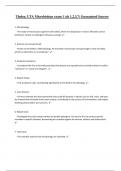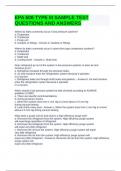Tholen, UTA Microbiology exam 1 (ch 1,2,3,7) Guaranteed Success
1. Microbiology:
- The study of microscopic organisms (microbes), which are ubiquitous in nature. Microbes can be
beneficial, neutral, or pathogenic (disease-causing). ✔️
2. Antoine van Leeuwenhoek:
- Known as the Father of Microbiology. He invented a microscope strong enough to view microbes,
which he referred to as "animalcules". ✔️
3. Giralamo Fracastoro:
- Considered the first to formally postulate that disease was spread by tiny invisible entities he called
"seminaria" or "seeds of contagion". ✔️
4. Robert Hooke:
- First to observe cells, contributing significantly to the field of microbiology. ✔️
5. Louis Pasteur:
- A French chemist who discovered that heat could kill bacteria in liquids such as milk, wine, and beer.
He showed that microbial strains were unique, contributed to the process of fermentation, and helped
develop pasteurization and vaccines. ✔️
6. Robert Koch:
- Developed the culture plate method to identify pathogens. He was the first to connect specific
microbes to specific diseases, discovering the causative agents for anthrax, cholera, and tuberculosis.
✔️
7. Taxonomy:
- The scientific study of how living things are classified. ✔️
, 8. Carolus Linnaeus:
- Known as the "Father of Taxonomy". He established the modern classification system called Binomial
Nomenclature and divided life into three kingdoms: animal, plant, and mineral. Sublevels include:
kingdom, class, order, family, genus, and species. ✔️
9. Phylogeny:
- The evolutionary history of a species or group of related species. ✔️
10. Ernst Haeckel:
- Known as the Father of Ecology. He proposed another kingdom for protists, which was later termed
monera. ✔️
11. Robert Whittaker:
- Added fungi as the fifth kingdom of eukaryotic microbes. He divided kingdoms into prokaryotes
(monera) and eukaryotes (fungi, protista, plantae, animalia). ✔️
12. Carl Woese and George Fox:
- Studied the small subunit of the ribosome and proposed a separate taxonomic unit: Archaea. They
developed a new taxonomic system representing three domains: Bacteria, Archaea, and Eukarya. ✔️
13. Binomial Nomenclature:
- A classification system where each species is assigned a two-part scientific name (italicized, with the
genus capitalized and species lower case). ✔️
14. Bergey’s Manual of Bacteriology:
- A manual for identifying and classifying microorganisms using non-visual characteristics. ✔️
15. Taxonomy Order:
- The hierarchical classification order is: Domain, Kingdom, Phylum, Class, Order, Family, Genus,
Species. ✔️





